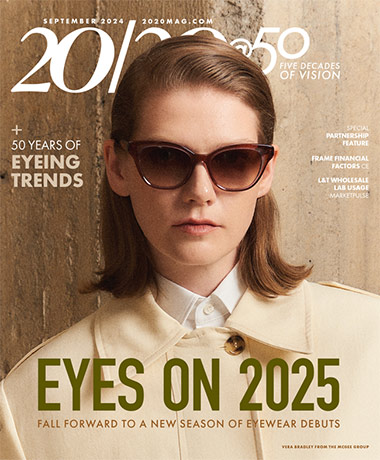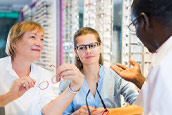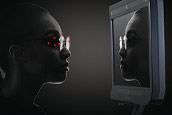Introduction
I was recently asked what I thought was the most valuable item in the Optical Heritage Museum collection. The Zeiss sponsored Museum in Southbridge, Mass. houses thousands of items chronicling American Optical's (AO) rich history, from its founding in 1833 to when it merged with Zeiss about 10 years ago. A large variety of antique spectacles, safety eyewear, Industry equipment, and even early Fiber optics development work (sponsored by the CIA in Southbridge at AO) are on display.

AO Lensometers from 1914 to late 20th Century
Choosing one item is difficult, but for me a small mahogany box immediately came to mind. Housed in this box is a unique set of lenses that I will refer to as AO's "NBS true-power standards" set from 1916. Perhaps after learning about what they are and how unusual they are, you will see why I treasure this set of lenses.
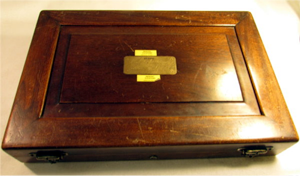
The mahogany box, and a similar secondary set, was stored for many years in my office for safekeeping. It is now on display where it belongs alongside many of AO's early Lensometer models, which these lenses were used to calibrate.
This article will describe this NBS set in some detail. In a subsequent "Part 2" on this topic, I will discuss my experiences with the standards for application in focimeter calibration. I will also provide advice on how you might apply some of this work to your own practice to monitor your focimeters.
AO NBS Traceable 1916 Set
In 1916, American Optical arranged for the National Bureau of Standards (Now known as NIST), to calibrate a set of glass standards of a specific configuration and power range.
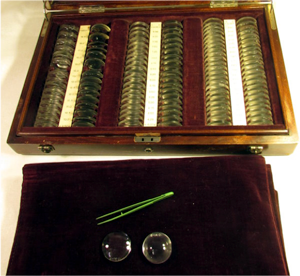
At this time, American Optical had just begun its work on developing an instrument to become known as the Lensometer. It was important to the success of this instrument to have a known, traceable set of lenses to use as its' master calibration set for the instruments produced.
When the lenses were calibrated at the National Bureau of Science, a young scientist was assigned this task to work on this project. His name was Edgar Tillyer, who joined AO after completion of this project at the NBS. "Doc" Tillyer would become AO's most famous scientist and a true giant in the field of ophthalmic optics. For more info on Doc Tillyer, check out this link on my website.
The NBS Truepower lens set contained pairs of lens powers from between +/- 0.12 D to +/- 20.0 Diopters. For weak powers up to 2.00 D, these sets were in 0.12 D increments. Between 2.25 and 8.00 D, the steps were in 0.25 D increments. Beyond that, the steps were in 0.50 intervals until 15.0. The remaining were in stepped by 1D until the +/- 20 powers were reached.
An important part of how these special lenses were designed and calibrated is in their unique geometry. The plus and minus powers were configured as matching sets, with one of its curves as flat surface. The curves for plus and minus lenses of a given dioptric power were mates to one another. In other words, when the concave of the minus lens was placed with the convex curve of plus lens, they were so closely matched that interference patterns referred to as Newton's Rings helped determine the accuracy of each curve.
Knowing the value of the curve and also knowing the second curve was a precision flat surface proved critical for determining the calibration power for each lens. Normally, lens thickness contributes to lens power, but given that one surface was flat this factor drops out. Finally, each lens had a sliver of glass removed from its edge to verify the index of refraction and this was also part of the certification process.
Armed with NBS traceable lens standards, American Optical developed the Lensometer and placed it in use in its laboratories before ultimately releasing the first model for sale in 1921. These lenses were an integral part of the success of this groundbreaking industry device. To my knowledge, they are the only set of its kind in existence in the world.
Over the decades, these lenses were used as the standards for the AO Lensometer. The secondary set was used to the extent that several lenses are now chipped and some missing as the must have broken with frequent use.
In the 1970s, three lenses were re-submitted to the NBS to see if they had changed in any way; they were determined to measure effectively the same by the NBS and as such, the entire set was re-certified.
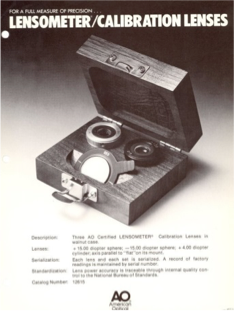
Other AO Lensometer Calibration lenses
In the late 1970s, AO sold a set of +/-15 D calibration lenses used to check the general calibration of the Lensometer, which were tested against the NBS set. Traceability testing for each of these lens sets involved comparing these lenses to the NBS on the same device.
Generally when verifying their power to the NBS lenses, 10 readings were taken where the NBS lens and test lenses were each placed and removed from the focimeter nose. By observing the measured differences between lenses, the lenses being provided had traceability to our original NBS set.
It turns out that for the AO Lensometer calibration check, using lenses at +/- 15D was a way to check to see if the mechanical settings had shifted with use.
As you will see in Part Two of this series, I found that using a set of lenses of weaker powers to provide a more useful "fingerprint" of the electronic focimeters now commonly in use.





